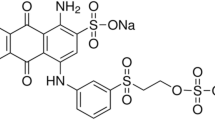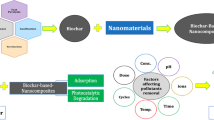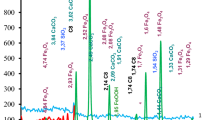Abstract
The release of industrial dyes into the environment has recently increased, resulting in harmful effects on people and ecosystems. In recent years, the use of adsorbents in photocatalytic nanocomposites has attracted significant interest due to their low cost, efficiency, and eco-friendly physical and chemical characteristics. Herein, Acid Orange 7 (AO7) removal was investigated by photocatalytic degradation using Rice Rusk Biochar (RHB), Tin (IV) Oxide (SnO2), and Iron Oxide (Fe3O4) as heterogeneous nanocomposite. After the preparation of RHB, the nanocomposite was synthesized and characterized using Field Emission Scanning Electron Microscope (FESEM), X-ray Powder Diffraction (XRD), Brunauer–Emmett–Teller (BET), and Fourier-Transform Infrared Spectroscopy (FT-IR). To optimize the elimination of AO7 by the One-Factor-At-a-Time (OFAT) method, effective parameters including mixing ratio (RHB:SnO2:Fe3O4), dye concentration, solution pH, and nanocomposite dose were studied. The results showed that the removal efficiency of AO7 after 120 min under the optimal mixing ratio of 1:1.5:0.6, dye concentration of 75 mg/l, solution pH of 4, and nanocomposite dose of 0.7 g/l was 92.37%. Moreover, Chemical Oxygen Demand (COD) and Total Organic Carbon (TOC) removal rates were obtained at 82.22 and 72.22%, respectively. The Average Oxidation State (AOS) and Carbon Oxidation State (COS) of the AO7 solution were increased after the process, indicating biodegradability improvement. Various scavenger effects were studied under optimal conditions, and the results revealed that O2− and H+ reactive species play a crucial role in the photocatalytic degradation of AO7. The reusability and stability of nanocomposite were tested in several consecutive experiments, and the degradation efficiency was reduced from 92 to 79% after five consecutive cycles. It is expected that this research contributes significantly to the utilization of agricultural waste in photocatalytic nanocomposites for the degradation of environmental pollutants.
Graphical abstract

















Similar content being viewed by others
Availability of data and materials
The authors declare that the data supporting the findings of this study are available within the article.
References
Xue, H., **ong, S., Mi, K., & Wang, Y. (2021). Visible-light degradation of azo dyes by imine-linked covalent organic frameworks. Green Energy & Environment. https://doi.org/10.1016/j.gee.2020.09.010
Baloo, L., Isa, M. H., Sapari, N. B., Jagaba, A. H., Wei, L. J., Yavari, S., Razali, R., & Vasu, R. (2021). Adsorptive removal of methylene blue and acid orange 10 dyes from aqueous solutions using oil palm wastes-derived activated carbons. Alexandria Engineering Journal, 60(6), 5611–5629. https://doi.org/10.1016/j.aej.2021.04.044
Danouche, M., El Arroussi, H., Bahafid, W., & El Ghachtouli, N. (2021). An overview of the biosorption mechanism for the bioremediation of synthetic dyes using yeast cells. Environmental Technology Reviews, 10(1), 58–76. https://doi.org/10.1080/21622515.2020.1869839
Sutar, S., Patil, P., & Jadhav, J. (2022). Recent advances in biochar technology for textile dyes wastewater remediation: A review. Environmental Research, 209, 112841. https://doi.org/10.1016/j.envres.2022.112841
Wang, Q., Zhang, W., Hu, X., Xu, L., Chen, G., & Li, X. (2021). Hollow spherical WO3/TiO2 heterojunction for enhancing photocatalytic performance in visible-light. Journal of Water Process Engineering, 40, 101943. https://doi.org/10.1016/j.jwpe.2021.101943
Berkani, M., Smaali, A., Kadmi, Y., Almomani, F., Vasseghian, Y., Lakhdari, N., & Alyane, M. (2022). Photocatalytic degradation of Penicillin G in aqueous solutions: Kinetic, degradation pathway, and microbioassays assessment. Journal of Hazardous Materials, 421, 126719. https://doi.org/10.1016/j.jhazmat.2021.126719
Hitam, C. N., & Jalil, A. A. (2020). A review on exploration of Fe2O3 photocatalyst towards degradation of dyes and organic contaminants. Journal of Environmental Management, 258, 110050. https://doi.org/10.1016/j.jenvman.2019.110050
Liu, N., Lu, N., Yu, H., Chen, S., & Quan, X. (2022). Enhanced degradation of organic water pollutants by photocatalytic in-situ activation of sulfate based on Z-scheme g-C3N4/BiPO4. Chemical Engineering Journal, 428, 132116. https://doi.org/10.1016/j.cej.2021.132116
Pant, B., Ojha, G. P., Acharya, J., & Park, M. (2021). Ag3PO4-TiO2-carbon nanofiber composite: An efficient visible-light photocatalyst obtained from electrospinning and hydrothermal methods. Separation and Purification Technology, 276, 119400. https://doi.org/10.1016/j.seppur.2021.119400
Luque, P., Nava, O., Soto-Robles, C., Chinchillas-Chinchillas, M., Garrafa-Galvez, H., Baez-Lopez, Y., Valdez-Núñez, K., Vilchis-Nestor, A., & Castro-Beltrán, A. (2020). Improved photocatalytic efficiency of SnO2 nanoparticles through green synthesis. Optik, 206, 164299. https://doi.org/10.1016/j.ijleo.2020.164299
Ali Baig, A. B., Rathinam, V., & Ramya, V. (2021). Facile fabrication of Zn-doped SnO2 nanoparticles for enhanced photocatalytic dye degradation performance under visible light exposure. Advanced Composites and Hybrid Materials, 4(1), 114–126. https://doi.org/10.1007/s42114-020-00195-9
Mohanta, D., & Ahmaruzzaman, M. (2021). Facile fabrication of novel Fe3O4-SnO2-gC3N4 ternary nanocomposites and their photocatalytic properties towards the degradation of carbofuran. Chemosphere, 285, 131395. https://doi.org/10.1016/j.chemosphere.2021.131395
Nazari, P., Askari, N., & Rahman Setayesh, S. (2020). Oxidation-precipitation of magnetic Fe3O4/AC nanocomposite as a heterogeneous catalyst for electro-Fenton treatment. Chemical Engineering Communication, 207(5), 665–675. https://doi.org/10.1080/00986445.2019.1613233
Djellabi, R., Yang, B., Sharif, H. M. A., Zhang, J., Ali, J., & Zhao, X. (2019). Sustainable and easy recoverable magnetic TiO2-lignocellulosic biomass@ Fe3O4 for solar photocatalytic water remediation. Journal of Cleaner Production, 233, 841–847. https://doi.org/10.1016/j.jclepro.2019.06.125
Torres, R., Diz, V. E., & Lagorio, M. G. (2022). Improved photosynthetic performance induced by Fe3O4 nanoparticles. Photochemical & Photobiological Sciences. https://doi.org/10.1007/s43630-022-00269-1
Albadarin, A. B., Collins, M. N., Naushad, M., Shirazian, S., Walker, G., & Mangwandi, C. (2017). Activated lignin-chitosan extruded blends for efficient adsorption of methylene blue. Chemical Engineering Journal, 307, 264–272. https://doi.org/10.1016/j.cej.2016.08.089
Siyasukh, A., Chimupala, Y., & Tonanon, N. (2018). Preparation of magnetic hierarchical porous carbon spheres with graphitic features for high methyl orange adsorption capacity. Carbon, 134, 207–221. https://doi.org/10.1016/j.carbon.2018.03.093
Li, W., Mu, B., & Yang, Y. (2019). Feasibility of industrial-scale treatment of dye wastewater via bio-adsorption technology. Bioresource Technology, 277, 157–170. https://doi.org/10.1016/j.biortech.2019.01.002
Al-Musawi, T. J., Rajiv, P., Mengelizadeh, N., Mohammed, I. A., & Balarak, D. (2021). Development of sonophotocatalytic process for degradation of acid orange 7 dye by using titanium dioxide nanoparticles/graphene oxide nanocomposite as a catalyst. Journal of Environmental Management, 292, 112777. https://doi.org/10.1016/j.jenvman.2021.112777
Zeng, H., Zeng, H., Zhang, H., Shahab, A., Zhang, K., Lu, Y., Nabi, I., Naseem, F., & Ullah, H. (2021). Efficient adsorption of Cr (VI) from aqueous environments by phosphoric acid activated eucalyptus biochar. Journal of Cleaner Production, 286, 124964. https://doi.org/10.1016/j.jclepro.2021.127046
Pang, Y. L., Law, Z. X., Lim, S., Chan, Y. Y., Shuit, S. H., Chong, W. C., & Lai, C. W. (2021). Enhanced photocatalytic degradation of methyl orange by coconut shell–derived biochar composites under visible LED light irradiation. Environmental Science and Pollution Research, 28(21), 27457–27473. https://doi.org/10.1007/s11356-020-12251-4
Eltaweil, A., Mohamed, H. A., Abd El-Monaem, E. M., & El-Subruiti, G. (2020). Mesoporous magnetic biochar composite for enhanced adsorption of malachite green dye: Characterization, adsorption kinetics, thermodynamics and isotherms. Advanced Powder Technology, 31(3), 1253–1263.
Hossain, N., Nizamuddin, S., Griffin, G., Selvakannan, P., Mubarak, N. M., & Mahlia, T. M. I. (2020). Synthesis and characterization of rice husk biochar via hydrothermal carbonization for wastewater treatment and biofuel production. Scientific Reports, 10(1), 1–15. https://doi.org/10.1038/s41598-020-75936-3
Wang, A., Zheng, Z., Li, R., Hu, D., Lu, Y., Luo, H., & Yan, K. (2019). Biomass-derived porous carbon highly efficient for removal of Pb (II) and Cd (II). Green Energy & Environment, 4(4), 414–423. https://doi.org/10.1016/j.gee.2019.05.002
Ahmadi, S., & Ganjidoust, H. (2021). Using banana peel waste to synthesize BPAC/ZnO nanocomposite for photocatalytic degradation of acid blue 25: Influential parameters, mineralization, biodegradability studies. Journal of Environmental Chemical Engineering, 9(5), 106010. https://doi.org/10.1016/j.jece.2021.106010
Sayadi, M. H., Sobhani, S., & Shekari, H. (2019). Photocatalytic degradation of azithromycin using GO@Fe3O4/ZnO/SnO2 nanocomposites. Journal of Cleaner Production, 232, 127–136. https://doi.org/10.1016/j.jclepro.2019.05.338
Barakat, M., Anjum, M., Kumar, R., Alafif, Z., Oves, M., & Ansari, M. O. (2020). Design of ternary Ni (OH)2/graphene oxide/TiO2 nanocomposite for enhanced photocatalytic degradation of organic, microbial contaminants, and aerobic digestion of dairy wastewater. Journal of Cleaner Production, 258, 120588. https://doi.org/10.1016/j.jclepro.2020.120588
Omer, A. M., El-Monaem, A., Eman, M., El-Subruiti, G. M., El-Latif, A., Mona, M., & Eltaweil, A. S. (2021). Fabrication of easy separable and reusable MIL-125 (Ti)/MIL-53 (Fe) binary MOF/CNT/Alginate composite microbeads for tetracycline removal from water bodies. Science and Reports, 11(1), 1–14.
Eltaweil, A. S., Abdelfatah, A. M., Hosny, M., & Fawzy, M. (2022). Novel biogenic synthesis of a Ag@ Biochar nanocomposite as an antimicrobial agent and photocatalyst for methylene blue degradation. ACS Omega, 7(9), 8046–8059.
Hosny, M., Fawzy, M., & Eltaweil, A. S. (2022). Green synthesis of bimetallic Ag/ZnO@ Biohar nanocomposite for photocatalytic degradation of tetracycline, antibacterial and antioxidant activities. Science and Reports, 12(1), 1–17.
Wang, D., Jiang, P., Zhang, H., & Yuan, W. (2020). Biochar production and applications in agro and forestry systems: A review. Science of The Total Environment, 723, 137775. https://doi.org/10.1016/j.scitotenv.2020.137775
Bi, Y., Sun, E., Zhang, S., Du, F., Wei, H., Liu, F., & Zhao, C. (2021). Synergistic effect of adsorption and photocatalysis for the degradation of toluene by TiO2 loaded on ACF modified by Zn (CH3COO)2. Environmental Science and Pollution Research, 28(40), 57398–57411. https://doi.org/10.1007/s11356-021-14539-5
Sannino, D., Morante, N., Sacco, O., Mancuso, A., De Guglielmo, L., Di Capua, G., Femia, N., & Vaiano, V. (2022). Visible light-driven degradation of acid orange 7 by light modulation techniques. Photochemical & Photobiological Sciences. https://doi.org/10.1007/s43630-022-00309-w
TaheriAshtiani, N., & Ayati, B. (2022). Using chitosan-based heterogeneous catalyst for degradation of Acid Blue 25 in the effective electro-Fenton process with rotating cathodes. Journal of Electroanalytical Chemistry, 905, 115983. https://doi.org/10.1016/j.jelechem.2021.115983
Damodar, R. A., You, S.-J., & Ou, S.-H. (2010). Coupling of membrane separation with photocatalytic slurry reactor for advanced dye wastewater treatment. Separation and Purification Technology, 76(1), 64–71. https://doi.org/10.1016/j.seppur.2010.09.021
Xu, C., Tan, X., Zhao, J., Cao, J., Ren, M., **ao, Y., & Lin, A. (2021). Optimization of biochar production based on environmental risk and remediation performance: Take kitchen waste for example. Journal of Hazardous Materials, 416, 125785. https://doi.org/10.1016/j.jhazmat.2021.125785
Bharatiya, D., Parhi, B., & Swain, S. K. (2021). Preparation, characterization and dielectric properties of GO based ZnO embedded mixed metal oxides ternary nanostructured composites. Journal of Alloys and Compounds, 869, 159274. https://doi.org/10.1016/j.jallcom.2021.159274
Al-Enizi, A. M., Naushad, M., Ala’a, H., Alshehri, S. M., Alothman, Z., & Ahamad, T. (2018). Synthesis and characterization of highly selective and sensitive Sn/SnO2/N-doped carbon nanocomposite (Sn/SnO2@NGC) for sensing toxic NH3 gas. Chemical Engineering Journal, 345, 58–66. https://doi.org/10.1016/j.cej.2018.03.138
Nnadozie, E. C., & Ajibade, P. A. (2020). Green synthesis and characterization of magnetite (Fe3O4) nanoparticles using Chromolaena odorata root extract for smart nanocomposite. Materials Letters, 263, 127145. https://doi.org/10.1016/j.matlet.2019.127145
Shakya, A., Núñez-Delgado, A., & Agarwal, T. (2019). Biochar synthesis from sweet lime peel for hexavalent chromium remediation from aqueous solution. Journal of Environmental Management, 251, 109570. https://doi.org/10.1016/j.jenvman.2019.109570
Leichtweis, J., Silvestri, S., & Carissimi, E. (2020). New composite of pecan nutshells biochar-ZnO for sequential removal of acid red 97 by adsorption and photocatalysis. Biomass and Bioenergy, 140, 105648. https://doi.org/10.1016/j.biombioe.2020.105648
Andronic, L., Isac, L., Cazan, C., & Enesca, A. (2020). Simultaneous adsorption and photocatalysis processes based on ternary TiO2–CuxS–fly ash hetero-structures. Applied Sciences, 10(22), 8070. https://doi.org/10.3390/app10228070
Noorimotlagh, Z., Kazeminezhad, I., Jaafarzadeh, N., Ahmadi, M., Ramezani, Z., & Martinez, S. S. (2018). The visible-light photodegradation of nonylphenol in the presence of carbon-doped TiO2 with rutile/anatase ratio coated on GAC: Effect of parameters and degradation mechanism. Journal of Hazardous Materials, 350, 108–120. https://doi.org/10.1016/j.jhazmat.2018.02.022
Zhang, Y., Su, P., Weathersby, D., Zhang, Q., Zheng, J., Fan, R., Zhang, J., & Dai, Q. (2020). Synthesis of γ-Fe2O3-ZnO-biochar nanocomposites for Rhodamine B removal. Applied Surface Science, 501, 144217. https://doi.org/10.1016/j.apsusc.2019.144217
Bechambi, O., Sayadi, S., & Najjar, W. (2015). Photocatalytic degradation of bisphenol A in the presence of C-doped ZnO: Effect of operational parameters and photodegradation mechanism. Journal of Industrial and Engineering Chemistry, 32, 201–210. https://doi.org/10.1016/j.jiec.2015.08.017
Rafiq, A., Ikram, M., Ali, S., Niaz, F., Khan, M., Khan, Q., & Maqbool, M. (2021). Photocatalytic degradation of dyes using semiconductor photocatalysts to clean industrial water pollution. Journal of Industrial and Engineering Chemistry, 97, 111–128. https://doi.org/10.1016/j.jiec.2021.02.017
Długosz, O., Staroń, A., Brzoza, P., & Banach, M. (2022). Synergistic effect of sorption and photocatalysis on the degree of dye removal in single and multicomponent systems on ZnO-SnO2. Environmental Science and Pollution Research, 29(18), 27042–27050. https://doi.org/10.1007/s11356-021-18044-7
Daneshvar, N., Aber, S., Dorraji, M. S., Khataee, A., & Rasoulifard, M. (2007). Photocatalytic degradation of the insecticide diazinon in the presence of prepared nanocrystalline ZnO powders under irradiation of UV-C light. Separation and Purification Technology, 58(1), 91–98. https://doi.org/10.1080/21622515.2020.1869839
Liu, B., Ye, L., Wang, R., Yang, J., Zhang, Y., Guan, R., Tian, L., & Chen, X. (2018). Phosphorus-doped graphitic carbon nitride nanotubes with amino-rich surface for efficient CO2 capture, enhanced photocatalytic activity, and product selectivity. ACS Applied Materials & Interfaces, 10(4), 4001–4009. https://doi.org/10.1021/acsami.7b17503
Fan, G., You, Y., Yan, Z., **a, M., Hong, L., Du, B., Luo, J., & Pang, H. (2021). Enhanced photocatalytic performance of Z-scheme N-doped Ag2CO3/GO (AGON) for microcystin-LR remediation under visible light. Journal of Water Process Engineering, 39, 101882.
Singh, T., Pal, D. B., Bhatiya, A. K., Mishra, P. K., Hashem, A., Alqarawi, A. A., AbdAllah, E. F., Gupta, V. K., & Srivastava, N. (2021). Integrated process approach for degradation of p-cresol pollutant under photocatalytic reactor using activated carbon/TiO2 nanocomposite: application in wastewater treatment. Environmental Science and Pollution Research. https://doi.org/10.1007/s11356-021-15454-5
Babu, S. G., Karthik, P., John, M. C., Lakhera, S. K., Ashokkumar, M., Khim, J., & Neppolian, B. (2019). Synergistic effect of sono-photocatalytic process for the degradation of organic pollutants using CuO-TiO2/rGO. Ultrasonics Sonochemistry, 50, 218–223. https://doi.org/10.1016/j.ultsonch.2018.09.021
Zhou, N., Chen, H., Feng, Q., Yao, D., Chen, H., Wang, H., Zhou, Z., Li, H., Tian, Y., & Lu, X. (2017). Effect of phosphoric acid on the surface properties and Pb (II) adsorption mechanisms of hydrochars prepared from fresh banana peels. Journal of Cleaner Production, 165, 221–230. https://doi.org/10.1016/j.jclepro.2017.07.111
Zahrani, A. A., & Ayati, B. (2020). Using heterogeneous Fe-ZSM-5 nanocatalyst to improve the electro Fenton process for acid blue 25 removal in a novel reactor with orbiting electrodes. Journal of Electroanalytical Chemistry, 873, 114456. https://doi.org/10.1016/j.jelechem.2020.114456
Mirzaee, S. A., Jaafarzadeh, N., Jorfi, S., Gomes, H. T., & Ahmadi, M. (2018). Enhanced degradation of Bisphenol A from high saline polycarbonate plant wastewater using wet air oxidation. Process Safety and Environmental Protection, 120, 321–330. https://doi.org/10.1016/j.chemosphere.2021.131395
Ghanbari, F., Moradi, M., & Manshouri, M. (2014). Textile wastewater decolorization by zero valent iron activated peroxymonosulfate: Compared with zero valent copper. Journal of Environmental Chemical Engineering, 2(3), 1846–1851. https://doi.org/10.1016/j.jece.2014.12.018
Ghalebizade, M., & Ayati, B. (2019). Acid orange 7 treatment and fate by electro-peroxone process using novel electrode arrangement. Chemosphere, 235, 1007–1014. https://doi.org/10.1016/j.chemosphere.2019.06.211
Armaković, S., Armaković, S., Finčur, N., Šibul, F., Vione, D., Šetrajčić, J., & Abramović, B. (2015). Influence of electron acceptors on the kinetics of metoprolol photocatalytic degradation in TiO2 suspension. A combined experimental and theoretical study. RSC Advances, 5(67), 54589–54604. https://doi.org/10.1039/C5RA10523D
Aharoni, N., Mamane, H., Biran, D., Lakretz, A., & Ron, E. Z. (2018). Gene expression in Pseudomonas aeruginosa exposed to hydroxyl-radicals. Chemosphere, 199, 243–250. https://doi.org/10.1016/j.chemosphere.2018.02.012
Khataee, A., Saadi, S., Vahid, B., Joo, S. W., & Min, B.-K. (2016). Sonocatalytic degradation of acid blue 92 using sonochemically prepared samarium doped zinc oxide nanostructures. Ultrasonics Sonochemistry, 29, 27–38. https://doi.org/10.1016/j.ultsonch.2015.07.026
Katsiev, K., Harrison, G., Alghamdi, H., Alsalik, Y., Wilson, A., Thornton, G., & Idriss, H. (2017). Mechanism of ethanol photooxidation on single-crystal anatase TiO2 (101). The Journal of Physical Chemistry C, 121(5), 2940–2950. https://doi.org/10.1021/acs.jpcc.6b12776
Wang, F., Yang, H., & Zhang, Y. (2018). Enhanced photocatalytic performance of CuBi2O4 particles decorated with Ag nanowires. Materials Science in Semiconductor Processing, 73, 58–66. https://doi.org/10.1016/j.mssp.2017.09.029
Ayala, L. I. M., Aparicio, F., Boffa, V., Magnacca, G., Carlos, L., Bosio, G. N., & Mártire, D. O. (2022). Removal of As (III) via adsorption and photocatalytic oxidation with magnetic Fe–Cu nanocomposites. Photochemical & Photobiological Sciences. https://doi.org/10.1007/s43630-022-00330-z
Yao, S., Zhou, S., Wang, J., Li, W., & Li, Z. (2019). Optimizing the synthesis of SnO2/TiO2/RGO nanocomposites with excellent visible light photocatalytic and antibacterial activities. Photochemical & Photobiological Sciences, 18(12), 2989–2999. https://doi.org/10.1039/c9pp00242a
Javadian, S., & Sadrpoor, S. M. (2019). Functionalized graphene oxide with core-shell of Fe3O4@ oliec acid nanospheres as a recyclable demulsifier for effective removal of emulsified oil from oily wastewater. Journal of Water Process Engineering, 32, 100961. https://doi.org/10.1016/j.jwpe.2019.100961
Zhang, X., Shao, D., Lyu, W., Tan, G., & Ren, H. (2019). Utilizing discarded SiC heating rod to fabricate SiC/Sb-SnO2 anode for electrochemical oxidation of wastewater. Chemical Engineering Journal, 361, 862–873. https://doi.org/10.1016/j.cej.2018.12.085
Acknowledgements
The authors would like to gratefully acknowledge the financial support from the M.SC. grant from Tarbiat Modares University and also, thank our colleagues who provided insight and expertise that greatly assisted the research.
Funding
This study was supported by an M.SC. grant from Tarbiat Modares University.
Author information
Authors and Affiliations
Contributions
All authors participated in designing the experiment, wrote, read and approved the final manuscript. Bita Ayati analyzed the data as well, Hamid Sadati performed the experiments.
Corresponding author
Ethics declarations
Conflict of interest
The authors declare that they have no known competing financial interests or personal relationships that could have appeared to influence the work reported in this paper.
Ethical approval and consent to participate
This material is the authors' own original work, which has not been previously published elsewhere.
Consent for publication
The authors give their consent for the publication of identifiable details, which can details within the text (material) to be published in the above Journal and Article.
Rights and permissions
Springer Nature or its licensor (e.g. a society or other partner) holds exclusive rights to this article under a publishing agreement with the author(s) or other rightsholder(s); author self-archiving of the accepted manuscript version of this article is solely governed by the terms of such publishing agreement and applicable law.
About this article
Cite this article
Sadati, H., Ayati, B. Using a promising biomass-based biochar in photocatalytic degradation: highly impressive performance of RHB/SnO2/Fe3O4 for elimination of AO7. Photochem Photobiol Sci 22, 1445–1462 (2023). https://doi.org/10.1007/s43630-023-00389-2
Received:
Accepted:
Published:
Issue Date:
DOI: https://doi.org/10.1007/s43630-023-00389-2




